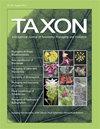推进梨属的系统发育:基于深度基因组略读的推断与旁系分析产生了一个稳健的系统发育骨架,并更新了梨属(马列,蔷薇科)的属下分类
IF 3
2区 生物学
Q2 EVOLUTIONARY BIOLOGY
引用次数: 0
摘要
梨属是欧亚大陆分布广泛的蔷薇科植物,由于缺乏强有力的系统发育主干,为提出梨属的下属分类法带来了巨大挑战。有限的信息位点和难以获得的类群取样加剧了这一问题。为了解决这些局限性,我们进行了广泛的分类群取样,包括代表 32 个物种的 78 个 Pyrus 内群个体以及 4 个外群物种。这种全面的取样策略涵盖了广泛的形态和地理变异。为了进行准确的系统发生学推断,我们从深度基因组撇取(DGS)数据中收集了 801 个单拷贝核基因和 72 个质体编码序列。此外,我们还采用了基于树的核同源推断方法,从而生成了三个同源数据集:一对一同源(1to1)、单系外群(MO)和有根内群(RT)。核分析和质粒分析的结果一致支持刺桐的单系性,在九棵核树和三棵质粒树中发现了两个支持良好的支系,即西方支系和东方支系。综合形态学和系统发生组学的证据,我们提出了一个更新的刺桐属下分类法,它由两个亚属组成:P. subg. Pyrus 和 P. subg. Pashia stat.修订后的分类为了解梨属内部的进化关系提供了一个更稳健的框架。本文章由计算机程序翻译,如有差异,请以英文原文为准。
Advancing Pyrus phylogeny: Deep genome skimming‐based inference coupled with paralogy analysis yields a robust phylogenetic backbone and an updated infrageneric classification of the pear genus (Maleae, Rosaceae)
The lack of a robust phylogenetic backbone has posed significant challenges to proposing an infrageneric taxonomic classification of the pear genus, Pyrus, a widely distributed Eurasian lineage of Rosaceae. This issue has been exacerbated by limited informative loci and inaccessible taxon sampling. To address these limitations, we conducted extensive taxon sampling, encompassing 78 Pyrus ingroup individuals representing 32 species, along with 4 outgroup species. This comprehensive sampling strategy covers a wide range of morphological and geographical variations. To enable accurate phylogenomic inference, we assembled 801 single‐copy nuclear genes and 72 plastid coding sequences from deep genome skimming (DGS) data. Additionally, we employed a tree‐based method for nuclear orthology inference, which led to the generation of three orthologous datasets: one‐to‐one orthologs (1to1), monophyletic outgroups (MO), and rooted ingroups (RT). The results yielded from both nuclear and plastid analyses consistently support the monophyly of Pyrus, and two well‐supported clades, the Occidental and Oriental clades, were recovered in nine nuclear and three plastid trees. Integrating evidence from morphology and phylogenomics, we propose an updated infrageneric classification of Pyrus, which consists of two subgenera: P. subg. Pyrus and P. subg. Pashia stat. nov. This revised classification provides a more robust framework for understanding the evolutionary relationships within the pear genus.
求助全文
通过发布文献求助,成功后即可免费获取论文全文。
去求助
来源期刊

Taxon
生物-进化生物学
CiteScore
4.70
自引率
8.80%
发文量
177
审稿时长
6-12 weeks
期刊介绍:
TAXON is the bi-monthly journal of the International Association for Plant Taxonomy and is devoted to systematic and evolutionary biology with emphasis on plants and fungi. It is published bimonthly by the International Bureau for Plant Taxonomy and Nomenclature, c/o Institute of Botany, Slovak Academy of Sciences, Dúbravská cesta 9, SK-845 23 Bratislava, SLOVAKIA. Details of page charges are given in the Guidelines for authors. Papers will be reviewed by at least two specialists.
 求助内容:
求助内容: 应助结果提醒方式:
应助结果提醒方式:


